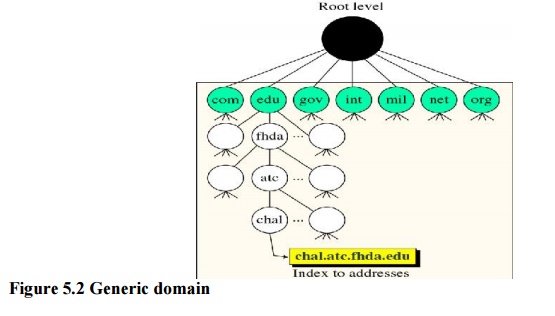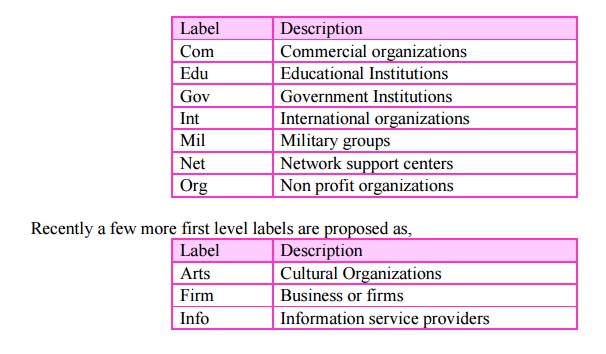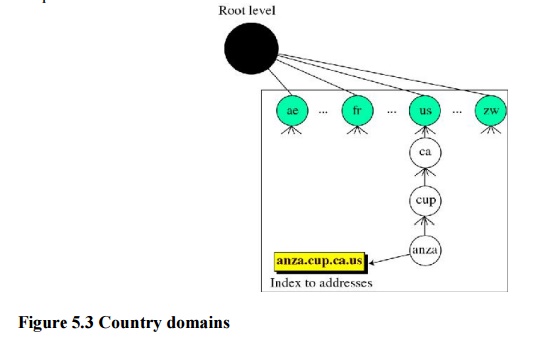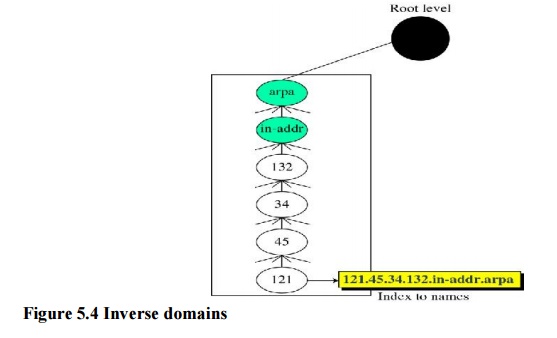Chapter: Computer Networks : Application Layer
Domain Name System
Domain Name System
There are
several applications in the application layer of the Internet model that follow
the client/server paradigm. The client/server programs can be divided into two
categories: those that can be directly used by the user, such as e-mail, and
those that support other application programs. The Domain Name System (DNS) is
a supporting program that is used by other programs such as e-mail.
1. Need for DNS
To
identify an entity, TCP/IP Protocols use the IP address, which uniquely
identifies the connection of a host to an internet. In the case of ARPANET, a
file named hosts.txt is used to list all hosts and their IP addresses, this
work suitable for small network but not for large network due to heavy load and
latency. Therefore, people prefer to use names instead of addresses that is, we
need a system that can map a name to an address and conversely an address to a
name. Thus, preferred system is called as Domain Name system.
2. DNS in the Internet:
DNS is a
protocol that can be used in different platforms. In the Internet, the domain
name space is divided into three sections are
1.
Generic domains
2.
Country domains and
3.
Inverse domain

1. Generic domain:
There are
14 generic domains, each specifying an organization type. The generic domain defines
registered hosts according to their generic behavior. Each node in the tree
defines a domain, which is an index to the domain mane space data base.

Looking
at the tree, we see that the first level in the generic domain section allows
seven possible three-character labels. These labels describe the organization
types as shown below


2. Country domains:
Each
country domain specifies a country. This section follows the same format as the
generic domains but uses two-character country abbreviations in place of three
character organizational abbreviations at the first level. Second level labels
can be organizational, or they can be more specific, national designations. The
following figure 5.3 shows the country domain section the address cs.Keio.ac.jp
refers to computer science department of Keio University in Japan. To create a
new domain, permission is required of the domain in which it will be included.
For
example, if a new university is chartered, say the University of Chennai, it
must ask the manager of the edu domain to assign it unc.edu, in order to avoid
conflicts and each domain can keep track of all its subdomains

Once a
new domain has been created and registered, it can create subdomains, such as
cs.unc.edu, without getting permission from anybody higher up the tree.
3. Inverse domain:
The
inverse domain finds a domain name for a given IP address. This is called
address-to-name resolution. It is used to map an address to a name. This may
happen, for example, when a server lists only the IP address of the client. To
determine if the client is on the authorized list, it can be send a query to
the DNS server and ask for a mapping of address to name in figure 5.4

3. Types of Records:
There are
two types of DNS records:
1.
Question records
2.
Resource records
Question Records:
The
question records are used in the question section of the query and response
messages. It is used by the client to get information from a server.
Resource Records:
Every
domain whether it is a single host or a top level domain, can have a set of
resource records associated with it. For a single host, the most common
resource record is just its IP address, but many other kinds also exist. When a
resolver gives a domain name to DNS, what it gets back are the resource records
associated with that name. Thus, the primary function of DNS is to map domain
names onto resource records. The server database consists of resource records.
This record is used in the answer, authoritative and additional information
sections of the response message.
4. Domain Name space:
DNS can
be pictured as an inverted hierarchical tree structure with one root node at
the top and a maximum of 128 levels.
Labels:
Each node
in the tree has a label, which is string with a maximum of 63 characters.
Domain Name:
Each node
in the tree has a domain name. A full domain name is a sequence of labels
separated by dots (.).
Fully Qualified Domain Name (FQDN):
A FQDN is
a domain name consisting of labels beginning with the host and going back
through each level to the root node. ExĂ
Challenger.atc.fh.da.Edu
Partially Qualified Domain Name (PQDN):
In PQDN
is a domain name that does not include all the levels between the host and the
root node. ExĂ Challenger.
5. Name Server:
In theory
atleast, a single name server could contain the entire DNS database and respond
to all queries about it. In practice, this server would be so overloaded as to
be useless. To avoid problems associated with having only a single source of
information, the DNS name space is divided into non-overlapping zones. One
possible way to divide the name space, where the zone boundaries are placed
within a zone is upto that zones administrator. This decision is made in larger
part based on how many name servers are desired. To improve reliability, some
servers for a zone can be located outside the zone.
The DNS
client, called a resolver, maps a name to an address, or an address to a name.
When a resolver has a query about the domain name, it passes the query to one
of the local name servers. If the domain being sought falls under the
jurisdiction of the name server, such as ai.cs.yale.edu falling under
cs.yale.edu, it returns the authoritative resource records. An authoritative
record is one that comes from the authority that manages the record and it thus
always correct. While, DNS helps in mapping names onto their IP addresses. It
does not help locate people, resources, services or objects in general. For
locating these things, another directory service has been defined, called LDAP
(Light Weight Directory Access protocol).
6. DNS Messages:
These are
two types of DNS Messages queries and responses. Both types have the same format.
Queries Messages:
The query
message consists of a header and question

Response Messages:
The
response message consists of a header, question records, answer records,
authoritative records and additional records.

7. Header Format:
Both are
have the same header format. The header is 12 bytes.
Identification
1.
Number of questions records
2.
Number of authoritative records. (All 0s in query
message)
Flags
1.
Number of answers records (All 0s in query message)
2.
Number of additional records. (All 0s in query
message)
The identification subfield is used by the
client to match the response with the query.
The flag subfield is a collection of
subfields that define the types of the message, the type of answer requested,
and the type of desired resolution and so on.
The Number of question records subfield
contains the number of queries in the question section of the message
The number of answer records subfield
contains the number of answer records in the answer section of the response
message. Its value is zero in the query message.
The number of authoritative records subfield
contains the number of authoritative records in the authoritative section of a
response message. Its value is zero in the query section.
The number of additional records subfield
contains the number of additional records in the additional section of a
response message. Its value is zero in the query message.
Related Topics